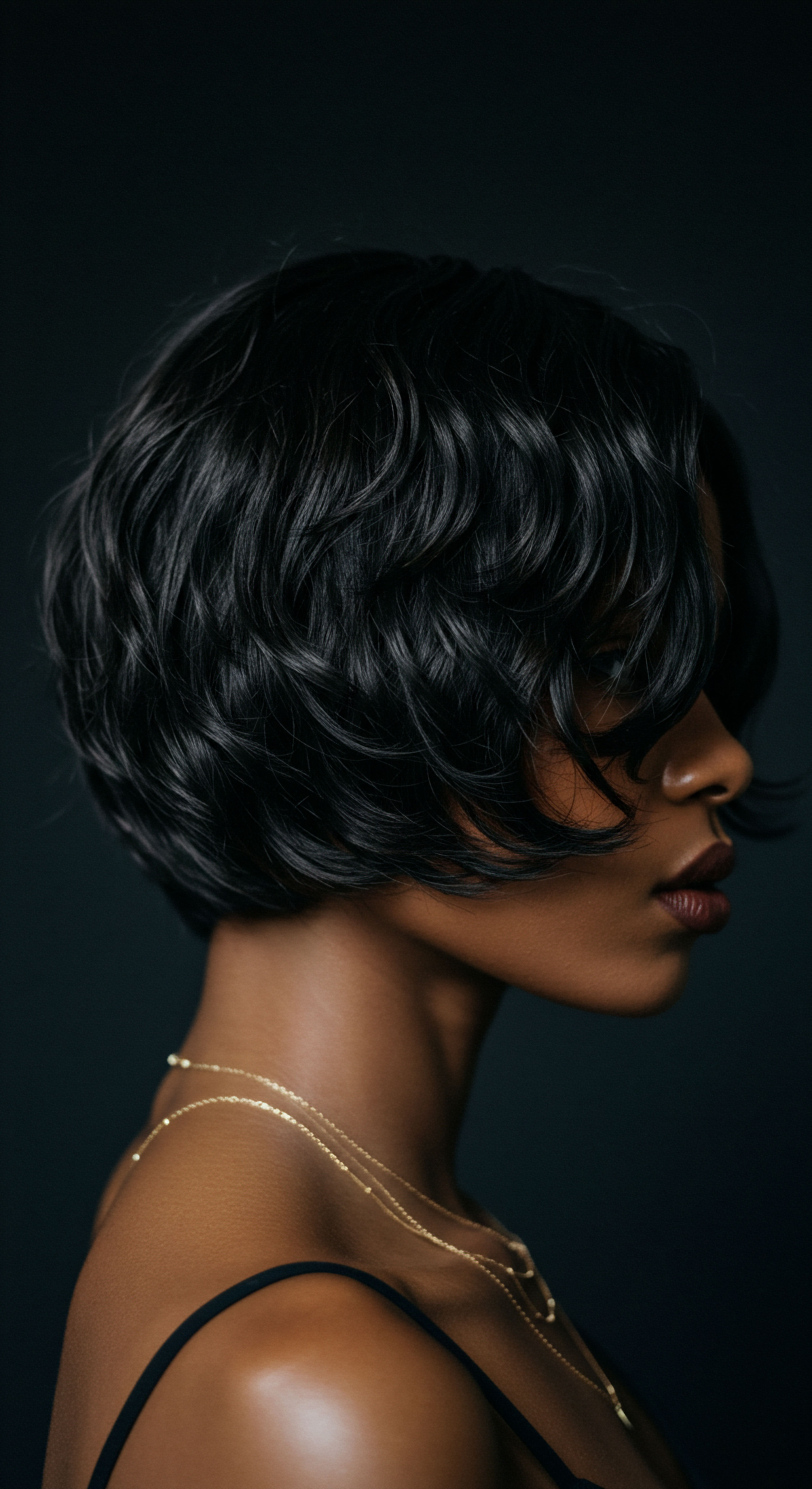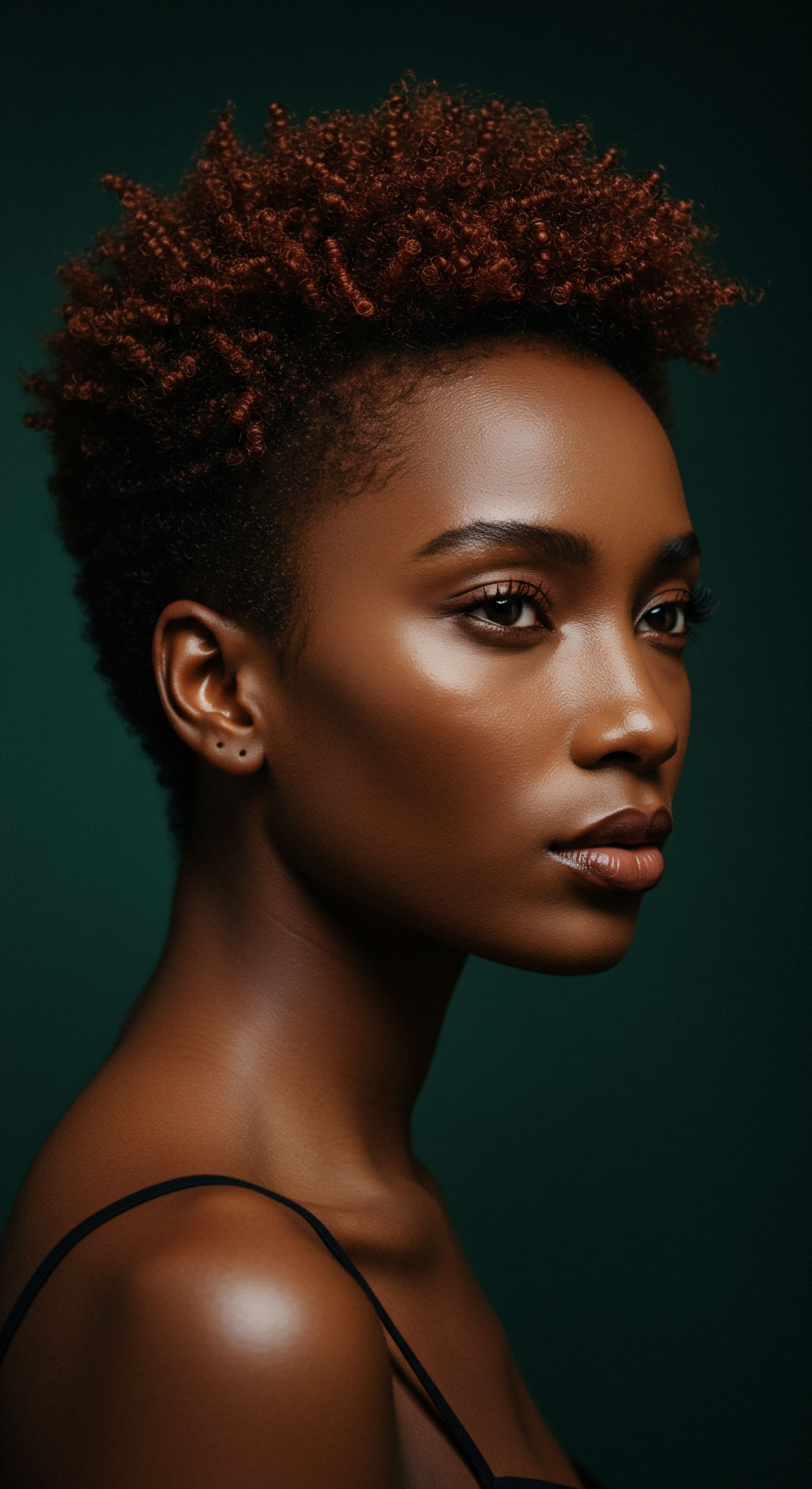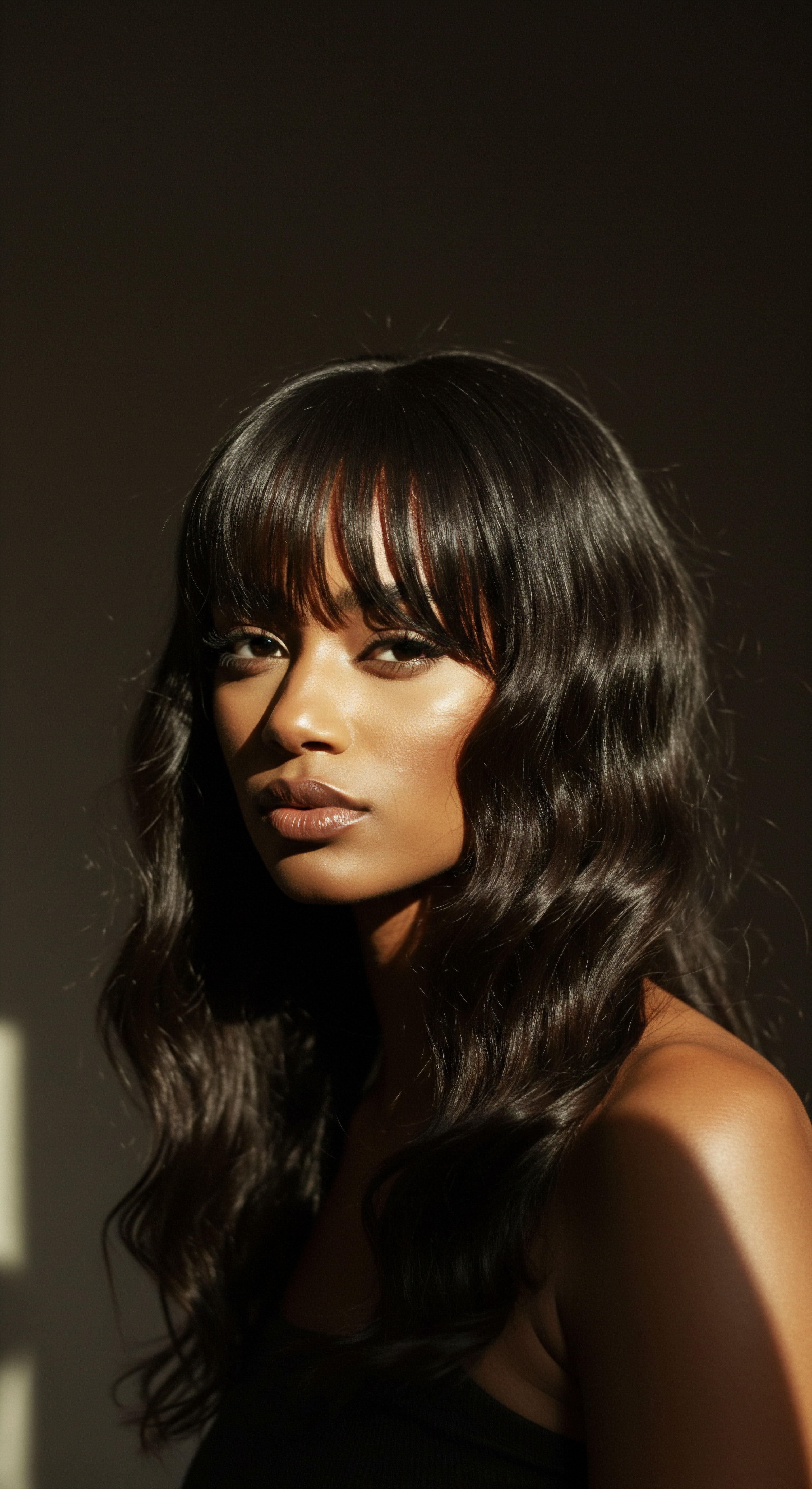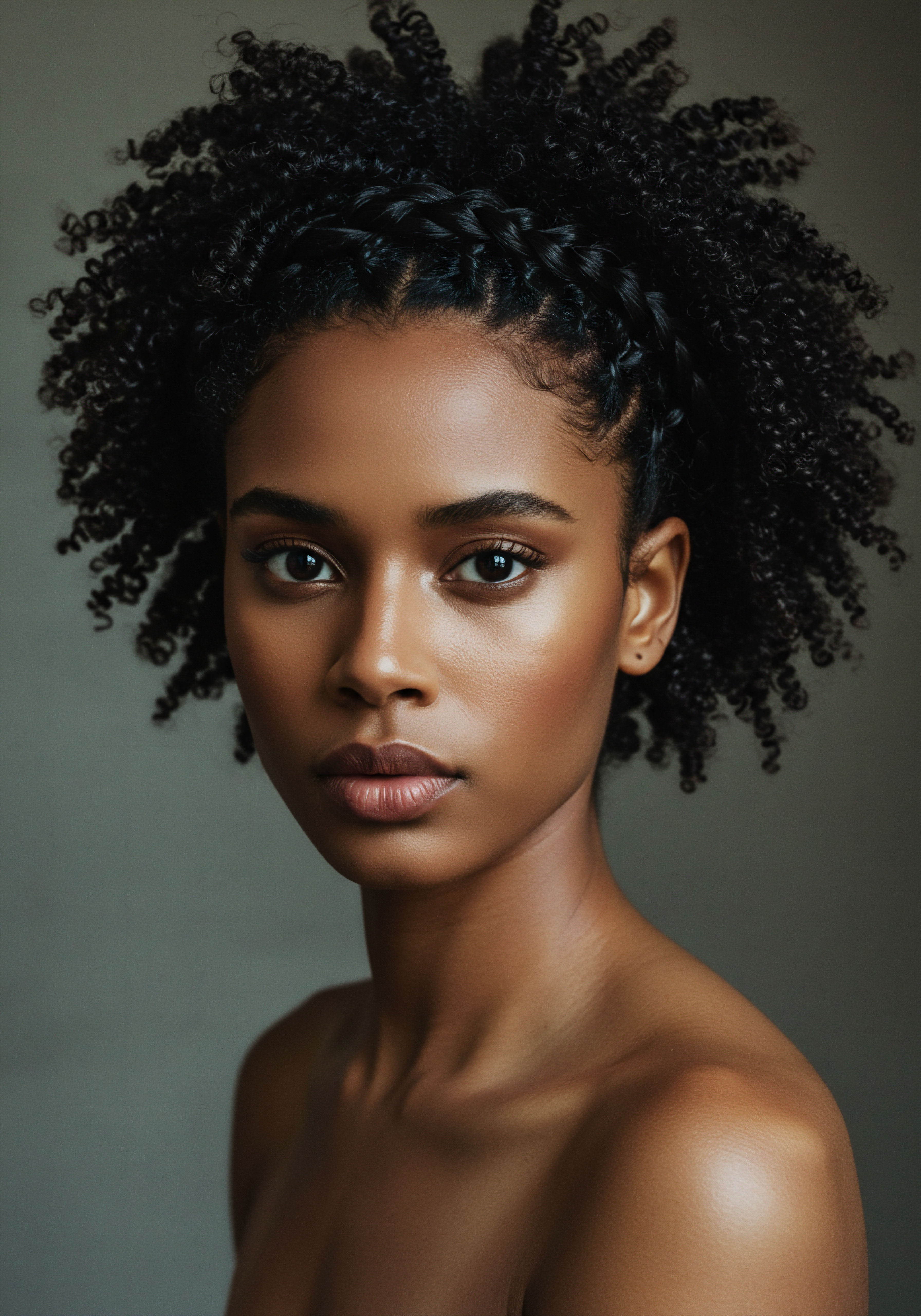
Roots
Consider the quiet strength held within each strand, a testament to ancestral wisdom echoing through time. Long before our modern laboratories and intricate formulas, people across diverse lands understood the subtle language of hair. They observed its responses to the elements, its yearning for sustenance, and its delicate architecture, much like the scales of a protective shell. This ancient understanding, often passed down through generations, laid the foundation for practices that inherently shielded the hair’s outermost layer, its cuticle, ensuring its vitality and sheen.
The hair cuticle, a microscopic arrangement of overlapping cells, forms the outermost shield of each strand. Picture it as the roof shingles of a tiny, individual house, where each shingle, or cell, lies flat and smooth when the hair is in its healthiest state. This tightly bound structure serves as the primary defense against external aggressors, whether they be environmental stressors, mechanical manipulation, or chemical exposures. When these scales are laid flat, they reflect light, lending hair its natural luster, and crucially, they seal in moisture, preventing the precious internal hydration from escaping.
Conversely, when the cuticle is compromised, these scales lift, leading to dryness, dullness, frizz, and an increased susceptibility to damage. Understanding this fundamental aspect of hair anatomy was, in many ways, an unspoken truth guiding historical hair care, even without the precise scientific terminology we employ today.

What is the Hair Cuticle and How Does It Protect?
The hair shaft, that visible part extending from the scalp, comprises three main layers ❉ the medulla (innermost core), the cortex (middle layer providing strength and color), and the cuticle. The cuticle’s role is primarily defensive. Its flattened, overlapping cells, rich in tough, inelastic protein, create a formidable barrier.
This shield protects the inner cortex from environmental harm, chemical treatments, and physical strain. A healthy cuticle maintains the hair’s structural integrity, contributes to its elasticity, and, significantly, regulates its moisture content by preventing excessive evaporation of natural oils and water.
When the cuticle is intact, hair feels smooth to the touch and possesses a natural shine. The smooth surface allows light to reflect evenly. When the cuticle is damaged, however, its cells lift, creating a rough surface that snags on other strands, leading to tangles and frizz.
This lifted state also means the hair is more porous, readily absorbing and losing moisture, which results in dryness and brittleness. Thus, the condition of this external layer directly dictates the hair’s overall appearance and resilience.
The hair cuticle, a shield of overlapping cells, safeguards the inner hair structure, reflects light for shine, and retains moisture for health.

Ancient Hair Wisdom and Its Unspoken Science
Long before electron microscopes revealed the intricate details of the cuticle, ancient civilizations intuitively grasped the principles of hair protection. Their methods, though seemingly simple, were deeply rooted in observation and the practical application of natural resources. They recognized that hair thrived with certain plant extracts, oils, and low-manipulation practices, even if they couldn’t articulate the exact molecular mechanisms. This collective wisdom formed a sophisticated, albeit unwritten, science of hair preservation.
Consider the practice of Hair Oiling, a cornerstone in many cultures, particularly in India. The Charaka Samhita, an ancient Indian text from the 1st century CE, described hair oiling as a daily regimen, emphasizing its importance for scalp health and hair strength. Modern science now validates this ancient practice ❉ oils, especially those with low molecular weights like coconut oil, can penetrate the hair shaft.
Coconut oil, rich in lauric acid, slips through the cuticle layers to nourish the cortex, preventing protein loss and reducing damage. This penetration helps to smooth and seal the cuticle, enhancing shine and manageability.
- Coconut Oil ❉ Its unique molecular structure allows it to penetrate the hair shaft, reducing protein loss and helping to lay the cuticle flat.
- Olive Oil ❉ Used in ancient Mediterranean cultures, it provides antioxidants and monounsaturated fats that nourish the scalp and hair, contributing to overall strength and elasticity.
- Almond Oil ❉ Employed by ancient Egyptians, it offers emollient properties, softening and moisturizing dry hair, and has been reported to increase hair elasticity by filling gaps between cuticle cells.

Ritual
As we move beyond the foundational understanding of hair’s outermost layer, a deeper appreciation for the practices that nurtured it across centuries emerges. These were not mere acts of grooming; they were often deliberate, rhythmic rituals, embodying a gentle guidance toward sustained hair vitality. Whether a daily anointing or a periodic restorative treatment, these methods spoke to a profound connection between the individual, their environment, and the innate needs of their strands. The wisdom of these routines offers insights into how practical application, rather than solely theoretical knowledge, truly safeguarded the hair’s protective shield.
Historical hair care practices, particularly those aimed at preserving the cuticle, frequently revolved around three core principles ❉ minimizing physical stress, providing external lubrication and moisture, and employing natural agents to support the hair’s structural integrity. These principles were applied through a diverse array of rituals, many of which continue to hold relevance today.

What Daily Habits Supported Hair Cuticle Health?
Across various cultures, daily or frequent habits played a significant role in maintaining cuticle health. These often involved gentle handling and the regular application of nourishing substances. For instance, in ancient India, the practice of daily Hair Oiling was a deeply ingrained custom.
Women would warm oils like coconut, sesame, or almond, sometimes infused with herbs like amla or bhringraj, and massage them into their scalp and along the hair lengths. This consistent lubrication reduced friction between hair strands, which in turn minimized cuticle lifting and damage during daily activities and detangling.
Similarly, in ancient Egypt, while wigs were common, natural hair received attention through cleansing with citrus juices and conditioning with almond oil. The use of plant-based extracts and natural oils was central to their hair care, contributing to shine and health by nourishing and protecting the cuticle.
Another subtle yet powerful practice was the use of specific rinses. The Red Yao women of China, renowned for their exceptionally long and healthy hair, have for centuries used Fermented Rice Water. This is not simply a quick rinse; the rice water is often fermented for several days.
Scientific examination reveals that fermented rice water contains inositol, a carbohydrate that helps repair damaged hair and protect it from future harm, along with amino acids that boost hair elasticity. This practice effectively smooths the cuticle and strengthens the hair, making it less prone to breakage.
Ancient hair rituals often centered on reducing physical stress and enriching strands with natural oils and botanical rinses.
| Traditional Lubricant Coconut Oil |
| Cultural Origin India, Southeast Asia |
| Primary Action on Cuticle Penetrates hair shaft, reduces protein loss, seals cuticle. |
| Traditional Lubricant Olive Oil |
| Cultural Origin Mediterranean, Greece, Rome |
| Primary Action on Cuticle Forms a protective barrier, provides emollient effect, nourishes. |
| Traditional Lubricant Almond Oil |
| Cultural Origin Ancient Egypt, Middle East |
| Primary Action on Cuticle Softens, moisturizes, helps fill gaps in cuticle cells, increases elasticity. |
| Traditional Lubricant Murumuru Butter |
| Cultural Origin Amazon Rainforest |
| Primary Action on Cuticle Deeply hydrates, controls frizz, penetrates hair shaft with fatty acids. |

How Did Protective Styles and Coverings Guard the Hair?
Beyond direct product application, the manner in which hair was styled and covered offered a significant layer of protection. Many historical hairstyles, particularly those prevalent in African cultures, were inherently protective. Styles like braids, twists, and Bantu knots minimized manipulation and exposure to environmental elements, such as extreme temperatures, humidity, and wind. These styles tucked away the hair, reducing tangles and knots, thereby preventing the constant friction and pulling that can lift and damage the cuticle.
Headwraps, too, served a dual purpose ❉ cultural expression and practical hair protection. In many African societies, headwraps were symbols of identity, status, and resistance. Simultaneously, they shielded the hair from harsh weather, dust, and sun, acting as a physical barrier against external damage.
This simple yet profound practice allowed hair to retain moisture and avoid the direct impact of environmental stressors that could compromise the cuticle. The resilience of these practices, often passed through generations, speaks to their efficacy in preserving hair health.

Relay
Stepping deeper into the historical landscape of hair care, we uncover a profound interconnectedness between environmental understanding, cultural identity, and the enduring quest for healthy strands. This journey moves beyond simple applications to a more complex interplay of elements, where the wisdom of ancestors, often gleaned from the natural world, provided sophisticated solutions for cuticle preservation. Here, the subtle dance of chemistry and tradition reveals itself, offering compelling insights into practices that stood the test of time, influencing hair vitality for millennia.
The protective measures for the hair cuticle in historical contexts were rarely isolated techniques. Instead, they formed part of a larger, holistic approach that recognized hair as an extension of overall well-being. This perspective integrated diet, environmental adaptation, and communal rituals, creating a comprehensive shield for the hair’s delicate outer layer.

What Unconventional Materials Aided Cuticle Protection?
While oils and plant extracts are widely recognized, some historical practices employed less conventional materials with surprising efficacy. For instance, the use of Clay Washes, particularly rhassoul and kaolin clays, was observed in various cultures, including those in Morocco. Unlike harsh soaps, these clays cleanse the hair without stripping its natural oils, which are vital for maintaining a smooth cuticle. Rhassoul clay, for example, is known for its ability to cleanse while leaving hair soft and conditioned, suggesting a gentle interaction that respects the cuticle’s integrity.
Another intriguing practice involves the use of Plant Mucilage. Certain plants, when steeped in water, release a slippery, gel-like substance (mucilage) that can coat the hair shaft. While specific historical documentation directly linking mucilage to cuticle protection is less explicit than for oils, its known properties suggest a role. For example, marshmallow root, sometimes mixed with rhassoul clay, was used for “incredible slip and shine,” indicating a smoothing effect on the hair.
This “slip” reduces friction during detangling, a major cause of cuticle damage. The mucilage would effectively act as a temporary sealant, laying down the lifted cuticle scales and providing a lubricated surface.
Consider also the less common, yet impactful, practice of Hair Steaming. While modern steamers are a recent invention, the principle of applying moist heat to hair has ancient roots. Historically, this could have been achieved through hot towels or by creating steamy environments, such as in bathhouses or by wrapping hair after applying warm treatments. The scientific understanding today is that moist heat encourages the hair cuticle to open gently, allowing conditioning products and oils to penetrate deeper into the hair shaft.
Following such a treatment, a cool rinse would then help to reseal the cuticle, trapping the newly absorbed moisture and nutrients within. This two-step process of opening and then closing the cuticle, though perhaps not fully understood chemically, was an intuitive method for maximizing product efficacy and then sealing the hair’s protective layer.
Beyond oils, historical hair care cleverly used materials like clays and the principles of moist heat to preserve the hair’s outer shield.

A Closer Look at the Impact of Fermented Rice Water
The tradition of the Red Yao women of Huangluo village in China offers a compelling case study on fermented rice water. Their average hair length, often reaching six feet, stands as a testament to the efficacy of their hair care regimen. Research indicates that fermented rice water contains inositol, a compound from the B vitamin family (specifically B8), which possesses the unique ability to penetrate the hair shaft and remain within the hair even after rinsing. This persistent presence of inositol provides ongoing repair to the hair’s keratin structure, contributing to its strength and elasticity.
Furthermore, the fermentation process itself enhances the concentration of amino acids and antioxidants in the rice water. Amino acids are the building blocks of proteins, and their presence helps to strengthen the hair’s internal structure, improving its resilience and elasticity by 10-15%. Antioxidants, meanwhile, combat environmental damage, which can otherwise degrade the cuticle.
This multi-pronged action – internal repair, elasticity enhancement, and external protection – highlights a sophisticated, data-backed approach to cuticle preservation, achieved through a seemingly simple, yet scientifically potent, traditional practice. The longevity and vibrancy of the Red Yao women’s hair provide a real-world, compelling data point for the effectiveness of this historical method.
- Inositol ❉ A carbohydrate found in fermented rice water that repairs damaged hair and protects it from future harm.
- Amino Acids ❉ Building blocks of proteins, these compounds, boosted by fermentation, improve hair elasticity and resilience.
- Antioxidants ❉ Present in fermented rice water, they help to neutralize free radicals and protect hair from environmental degradation.

How Did Dietary and Environmental Factors Influence Hair Health?
The health of the hair cuticle was not solely dependent on external applications; historical understanding often extended to the influence of diet and environmental adaptation. Many cultures consumed diets rich in nutrients that supported hair health from within. For instance, populations with access to diverse plant-based foods, healthy fats, and proteins likely benefited from the internal nourishment these provided to the hair follicles and, subsequently, the hair shaft.
In India, a healthy diet rich in vitamins, minerals, and proteins, including leafy greens, nuts, seeds, and fruits, was considered essential for strong, healthy hair. Hydration through sufficient water intake was also seen as vital for maintaining scalp and hair moisture.
Moreover, environmental adaptations played a subtle but significant role. People living in arid climates, for example, would instinctively rely more heavily on occlusive oils and protective styles to shield their hair from drying winds and intense sun exposure, both of which can lift the cuticle and cause moisture loss. The strategic use of head coverings, as discussed earlier, directly addressed these environmental challenges, preventing the cuticle from being constantly assaulted by the elements. This inherent understanding of environmental impact, coupled with nutritional wisdom, formed a comprehensive approach to cuticle preservation that was both reactive and preventative.

Reflection
Our journey through historical hair care practices reveals a profound, enduring wisdom that transcends the confines of time and geography. It reminds us that the quest for healthy, resilient hair is not a modern phenomenon, but a deeply human endeavor rooted in observation, ingenuity, and a respectful connection to the natural world. The practices of generations past, though lacking the scientific vocabulary of today, intuitively understood the delicate architecture of the hair cuticle and devised methods to honor its protective role.
As we stand at the crossroads of ancient tradition and contemporary science, there is an invitation to rediscover these gentle yet potent approaches, allowing their quiet efficacy to inform our present-day regimens. Perhaps the true legacy of these historical practices lies not just in their proven benefits, but in their timeless call for a more mindful, holistic engagement with our hair, celebrating its strength, its beauty, and its deep cultural resonance.

References
- Areté. (n.d.). Daily Rituals Hair Wash (7.4oz). Retrieved from Holistic Hair Tribe.
- Banyan Tree Essentials. (2019, June 19). The History of Hair Care.
- Clinikally. (2024, June 3). Reviving Ancient Hair Rituals ❉ Exploring the Therapeutic Art of Hair-Oiling.
- Colomas, J. (2023, December 2). Unlock Ancient Hair Care Secrets ❉ Discover Global Rituals for Lustrous Locks.
- Enviiri Hair Salon. (2023, July 22). 3 Unique Haircare Traditions from Around the Globe.
- Fabulive. (n.d.). Rediscovering Historical Hair Care Practices.
- FullyVital. (2023, June 20). The Importance of Cuticle for Hair Regrowth and Combating Grey Hair ❉ A Comprehensive Guide.
- Global Fashion. (2024, June 7). Top 9 Indian tips on how to grow long and shiny hair.
- Harper’s BAZAAR. (2020, August 6). The best hair steamers for natural hair ❉ what is hair steaming?
- Hairstory. (2024, September 27). Conditioner ❉ Everything You Need to Know.
- Healthyfly. (2024, September 17). Coconut Oil Elixir ❉ A Time-Honored Beauty Secret in Ancient India.
- Kiyo Beauty. (n.d.). The Mane Choice Ancient Egyptian Cuticle Control Control Leave-In Lotion.
- Laifen-EU. (2024, November 5). What Is a Hair Cuticle | Your Hair’s Protective Layer.
- Maternal Ark. (n.d.). Ancient Hair Treatment ❉ Fermented Rice Water.
- MDPI. (n.d.). Known and Unknown Features of Hair Cuticle Structure ❉ A Brief Review.
- National Institute. (2023, April 25). The Evolution of Hair & Scalp Treatments ❉ Hair Care History.
- Obé Headwear. (2024, August 5). Significance of headwraps.
- Orifera. (2024, October 13). The History of Coconut Oil and Its Cultural Significance Across the World.
- Pattern Beauty. (2024, October 11). The Top 4 Benefits of Steaming Hair.
- Prose. (2021, August 18). What is a Hair Cuticle | Your Hair’s Protective Layer.
- Rolling Out. (2025, April 28). The ancient haircare secret that’s backed by modern science.
- Saabuni. (n.d.). The Ultimate Guide to Indian Hair Care ❉ Unlocking the Secrets to Luscious Locks.
- Smithsonian National Museum of African American History and Culture. (2023, August 16). Strands of Inspiration ❉ Exploring Black Identities through Hair.
- The Mane Choice. (n.d.). Ancient Egyptian Anti-Breakage and Repair Antidote Leave In Conditioner.
- The Pretty Girls Guide. (2014, October 21). How To Shower Steam Your Hair & Steam Benefits.
- Wikipedia. (n.d.). Protective hairstyle.